Cost reduction and proper optimization of resources is fundamental to any company’s strategy. However, cuts should not just be made; it is important to control cost reductions and to ensure that such reductions do not affect the company.
How to know when to cut costs in a company
The optimization and reduction of the company’s expenses does not necessarily have to be carried out in times of economic crisis, but has to be carried out on a permanent basis by the company’s manager.
control
should be carried out on a permanent basis by the company’s manager. Thus, permanent cost control will avoid falling into unnecessary and assumed costs that any company can do without because they are not essential for the production of the product or the provision of the service it markets. However, in times of economic crisis, cost-cutting is not only essential, it is almost mandatory.
How should we apply cost reduction in a company?
First of all, it is important to be very clear that reducing expenses is a limited measure, since there are costs that are indispensable and inherent to the activity carried out by any company, without which the entity will not be able to carry out its activity.
Cost reduction in a company
Once the cost structure of the company is known and it has been determined in which (variable) expenses can be cut, it is time to take measures to reduce costs in a company.
Reduction of fixed costs
They make the difference in the long run. The keys to reducing fixed costs are as follows.
Outsource secondary functions: small and medium-sized companies should not have certain departments that are not the main activity for the business. A department not only needs its own space (which is reflected in the size of the offices), but also the personnel in charge of it. In these cases, it is advisable to hire an external company to carry out these tasks, such as human resources, marketing, management or auditing, among others.
Reduce small non-essential expenses: Avoiding the sum of many small expenses can result in significant savings, and it can even become a company philosophy to continuously seek savings in every process that is carried out. These types of expenses are very different depending on the company, but it is advisable to carry out a small analysis to identify what is not really needed, or what should be maintained. Some examples that most companies have are:
- Reduced paper expenses: opt for digital methods, such as electronic invoices instead of traditional ones, so you will save on paper, courier and printing costs. Implement personal and team task control tools, or note-taking tools, so that the team consumes less and less paper and gets used to using the computer for all these tasks. In addition, it is faster, safer, and more environmentally friendly.
- Repair and care of equipment: correct use and consideration of repairs when necessary will extend the useful life of IT equipment, allowing you to delay the investment in the purchase of new units.
- Selling equipment or materials on second-hand platforms: If equipment upgrades are necessary, you can always obtain an income from these equipment on the second-hand market, helping both the environment and start-up companies that may need high quality equipment but do not yet have the capacity to acquire new equipment.
Take advantage of bonuses and subsidies:In many occasions, there are bonuses for hiring professional profiles with certain characteristics, the best thing to do is to count on a management company to guide us with regard to personnel expenses so that they can inform us of possible bonuses at our disposal that it would be a pity not to apply for pure ignorance.
Reduction of variable expenses
In order to reduce variable costs, a series of measures must be implemented.
Negotiate with your suppliers: suppliers usually offer discounts to their most loyal customers or to those who make a good cash outlay. Thus, buying large quantities (always taking into account the future cash needs of our company) can mean significant savings in the long term. In any case, research which supplier is the best and which is the cheapest, so you will have enough perspective and information to be able to negotiate.
Apply the principles of Lean Management: through these principles we try to avoid waste in the processes of a company and, with this, seek continuous improvement of the same, achieving an optimal use of resources. This also means savings in the long term, since resources that expire or are wasted cost money, and the fewer resources that are wasted, the greater the savings.
Automate by applying technology at your fingertips: bet on technology for those repetitive or administrative tasks through tools designed for these actions, such as Zapier or Integromat. These tools will allow you to automate all kinds of tasks by integrating with the most used tools in the market (CRMs, ERPs, Google Docs, Emails…). In itself, this option will not directly save you costs, but your team will save time, and will be able to focus on the tasks that really add value and therefore be more efficient.
Undoubtedly, by implementing this series of guidelines, you will be able to reduce non-essential expenses and optimize your company’s resources, thus extending its life.





